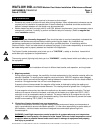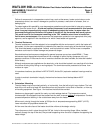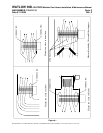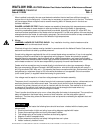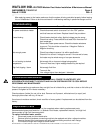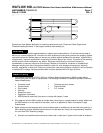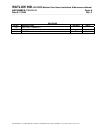
WATLOW IND. WATROD Modular Duct Heater Installation & Maintenance Manual
I&M NUMBER: 316-42-15-1 Page: 4
Date:6/11/2008 Rev: 2
_________________________________________________________________________________________________________________________________________________________________________________________________________________________
______
WATLOW IND.n # 6 INDUSTRIAL LOOP RD. n HANNIBAL MO, 63401n PHONE 314-221-2816 n FAX 314-221-3723
When installed horizontally the user must determine whether the duct wall has sufficient strength to
support the unit by the flange only. A frame may be necessary to support the unit in the duct. This frame
can have tapped holes or captive nuts to receive mounting bolts. An access panel in the duct can
facilitate installation.
DANGER: HAZARD OF FIRE. Electric heaters are capable of developing high temperatures so extreme
care should be taken to locate heaters in safe environments. Mounting heaters in atmospheres
containing combustible gases and vapors should be avoided. According to article 501 of the NEC, the
maximum surface temperature of the heater shall not exceed 80 % of the auto-ignition of the surrounding
atmosphere when the heater is continuously energized. Care should also be taken to keep combustible
materials far enough away to be free of the effects of high temperatures.
5. Wiring
WARNING;
HAZARD OF ELECTRIC SHOCK. Any installation involving electric heaters must be
grounded to earth to eliminate shock hazard.
Electrical wiring to the heaters must be installed in accordance with the National Electric Code and any
state and local electrical code by qualified personnel.
Consult wiring diagram supplied with the unit for correct feeder wires connections. If one is not supplied,
the factory should be consulted for the appropriate wiring diagram. Feeder wire should be properly
selected based on amperage, electrical power rating, ambient temperature, and type of environment.
Feeder wire should also be housed in either rigid or flexible conduit which carries the same classification
as the heater enclosure. It is the users responsibility to properly size and install feeder wire.
Feeder wire line connections may be made directly to stud terminals or box type compression fittings.
Box type compression fittings will accept a #4 AWG maximum wire while stud terminals will accept a
#10 ring connector(T&B, Amp, etc.). It is essential that these connections be tight. Stud terminals should
be tightened to a maximum torque of 20 in-lbs while the bottom nut is supported. Ground connection
(color coded "green") is supplied inside the housing for ground wire.
Line voltage must be equal to or less than rating stamped on the heater assembly.
The power circuit is required to include a branch circuit overcurrent protective device, a disconnect and a
secondary thermal cut-out with manual reset. The control circuit should include the temperature
controller, the primary thermal cut-out and an interlock with the fan motor. One method to do this is with
a pressure air flow switch. It will open the control circuit and de-energize the heater when any
circumstance prevents sufficient air flow through the heater.
The air handler should be set up to run on a time delay after the heater is de energized. The correct time
delay will depend on the blower rating, amount of duct insulation, and the total power output of
heaters(s). The time delay allows the elements to cool and prevents overheating the adjacent duct and
terminal areas.
Start Up
Before energizing the heater the following items should have been checked with the heater power
disconnected:
1. Electrical termination is tight and wiring is per wiring diagram supplied with heater
2. Proper disconnecting means and fusing have been installed
3. The voltage rating of the heater is the same as that being applied
4. Megohm is within acceptable limits
5. Proper temperature controls and safety limiting devices are in place
6. Heater is securely installed in duct



